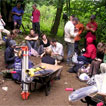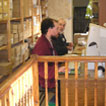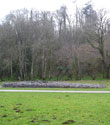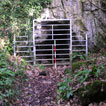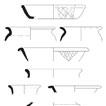What does it mean?
We can now say that there was at least one Roman building at Church Hill, with stone walls and a tiled roof. A tiny scrap of wallplaster picked up by Mrs Grove, and a couple of small cubes of stone that are probably tesserae from a mosaic, show that it had sophisticated decoration. There was also a central heating system, as some of the tiles were hollow box-tiles that were mortared onto the walls to carry hot air from a hypocaust, where air that had been heated by a furnace could be circulated under the floor. Far too much money was spent on it for it to be just and an ordinary peasant farmstead. However, this building was probably not a villa, because the pottery is rather plain and does not include much in the way of the sort of tablewares you would expect in a villa, and we also do not have very much in the way of metal objects — for instance we did not find any coins. There is no evidence that it was a military site either — there are no finds typical of the Roman army, and it´s not placed a useful tactical or strategic position.
One possible interpretation is that we may be dealing with some sort of temple or sanctuary. If you go straight down the slope from the site into Green Cwm, you find yourself at the Neolithic chambered tomb. On the opposite side of the valley, about 200m from our site is Cat Hole, a cave where there are Bronze Age burials, and 1km further up the cwm is Tooth Cave which was also used for burial in the Bronze Age. Perhaps what we have here is an area of religious significance that kept its importance for thousands of years. However we have gaps. There is a gap between the Bronze Age burials and the Roman site, and then what looks like another gap at the end of the Roman period.
The fact that the enclosure was created over the ruins of a Roman site groups Church Hill with other Roman sites that seem to have continued in use after the Roman period. For instance, at Loughor there is an Early Medieval inscription on a Roman altar that uses the ogam alphabet, which was introduced from Ireland and was in use in the 5th and 6th centuries AD. St Michael´s church, Loughor, is directly on top of the Roman fort, and it looks as though the fort was adopted as a centre of early Christianity. Other Roman sites where this happened were Llandough near Penarth, where an important monastery grew up over a Roman villa, and Caerleon, where St Cadoc´s church was built over the headquarters of the Roman fortress. Some pre-Norman churches were founded in circular or near-circular enclosures with banks around them, very much like the one at Church Hill. The name itself may indicate that there was church here. Certainly there is nothing in the surviving documents that would show that the site had any connection with any known church — perhaps only the name remains to show that this was once an Early Christian site. But was it converted from a pagan sanctuary that went back to Roman times? And did it go further back still to the earliest times when people started to build monuments in Gower? We are beginning to see a few sites in Wales where there seems to have been activity, and often activity associated with ritual, concentrated into a very small area over a long period, although it may move a little way from one period to another. The best studied is the one at Parc Bryn Cegin, Llandegai near Bangor, where the Gwynedd Archaeological Trust has excavated an area of 23 hectares ahead of development. Is Green Cwm the centre of another?

